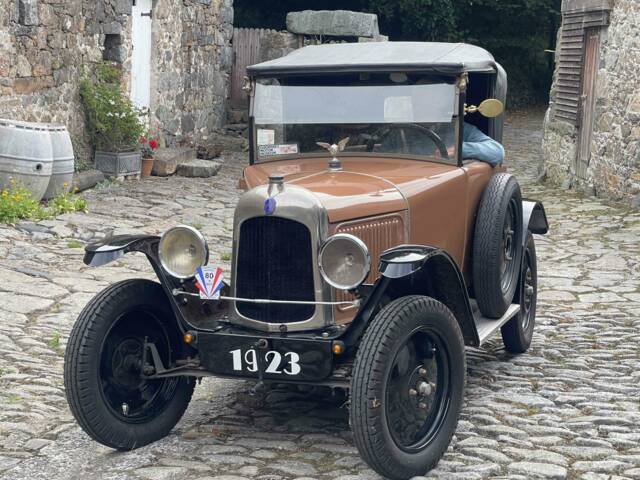Citroën Typ C Classic Cars for Sale
The Citroën Typ C, also known as the Citroën 5HP, is a milestone in the early 1920s French automotive scene. Designed to be affordable, accessible, and easy to drive, this compact car offered a stylish driving experience, a nimble engine, and an innovative approach for its era. Over 81,000 units found buyers between 1922 and 1926, cementing its legacy as a pragmatic yet distinctive vehicle for a wide audience.
Search results

1923 | Citroën C2 5HP Boattail
5CV Cabriolet Boulogne - LHD
History of the Citroën Typ C
Launched in 1922 and devised by Edmond Moyet, the Citroën Typ C quickly became a notable presence on European roads, first revealed at the Paris Salon in 1921. Initially available only in yellow—leading to the affectionate nickname 'Petit Citron' or 'Little Lemon'—it was intended as an entry-level offering below the Citroën B2, targeting a less affluent customer base. Early on, the Typ C captured public imagination with its compact 'boat-deck' body and three-seat 'Cloverleaf' (Trèfle) layout, reflecting both engineering creativity and a keen sense for automotive trends. By 1924, the model adopted the C3 designation, remaining on the market until 1926, when Citroën shifted focus to newer models and steel-body production technology.
Model History: Citroën Typ C Evolution
The Typ C sat below the larger Citroën B2 and was followed in 1923 by the C2 version, featuring improvements in the chassis and ignition system. The subsequent C3 in 1924 extended the wheelbase to 2.35 metres, added rear-wheel shock absorbers and diversified body styles. Notable variants included the two-seat Torpedo, the distinctive Trèfle (with a small rear seat), and various Cabriolet configurations. Manufacture ended in 1926 due to a strategic decision by André Citroën to harmonise production, but the Typ C's influence was evident in future models such as the 2CV.
Highlights of the Citroën Typ C
The Typ C gained acclaim for being purpose-built for new driving demographics, particularly women, with user-friendly features like an electric starter as standard. It also broke ground in automotive marketing, being offered with innovative instalment financing via a dedicated Citroën credit company. Signature elements include a single side door, rear-mounted spare wheel, lightweight construction, and a highly recognisable yellow paint scheme.
Technical Data of the Citroën Typ C
Special Editions and Collectible Models
Among the most notable Typ C variations is the Trèfle (Cloverleaf), a three-seater version with a single rear seat, whimsically called the 'mother-in-law's seat.' Additionally, C2 and C3 Cabriolet models, as well as the C2 Tourer (a two-seater), offered greater variety for customers. The yellow 'Citron' Cabriolet holds particular historical significance for its vivid colour and role in Citroën's public image campaigns.
Weak Spots and Common Issues
There is no specific information provided on typical weak points of the Citroën Typ C in the supplied data. For prospective buyers, it is advisable to check for period-correct mechanical integrity, wear on suspension components, and originality of key features (such as the bodywork, unique chassis configurations, and early electrical systems), which can often be points of attention on any nearly century-old automobile.
Engine, Transmission and Handling
The 856 cc engine delivers modest performance by today's standards, but was more than adequate for the Typ C's ultralight body. With rear-wheel drive and a simple 3-speed gearbox, the car is easy to drive for its time. Suspension is basic but effective—elliptic leaf springs absorb rough surfaces, while the small size makes the Typ C agile in urban environments. Braking relies solely on the rear wheels, requiring anticipation in emergency stops. Later models, with extended wheelbase and added rear dampers, offered slightly improved comfort for passengers. Popular Typ C models include:
- C2 Tourer: stripped-down, two-seater configuration
- C2/C3 Cabriolet: convertible versions, especially attractive in the yellow 'Citron' colour
- Trèfle (Cloverleaf): the best known, with unique 3-seat variant and signature 'boat deck' shape
Interior, Comfort, Exterior and Design Features
The Typ C's minimalist interior reflected its practical intent: basic instrumentation, an airy body design, and a single door on the passenger side, with a spare wheel mounted on the left. The exterior's 'boat-deck' rear and the bright yellow finish set it apart visually, while the compact dimensions ensured easy manoeuvrability. Options included convertible tops, unique seating arrangements in the Trèfle variant, and optional accessories such as additional lights or luggage carriers—a rare offering in its price segment at the time.
Other Noteworthy Features
Citroën offered Typ C customers innovative credit solutions for vehicle purchase, fostering greater accessibility. Early publicity targeted women specifically, reflecting the car's user-friendly character—a rare approach for the 1920s car market.
Summary
The Citroën Typ C remains a pivotal member of early 20th-century European motoring, representing Citroën's drive for accessibility and innovation in the post-war era. Its distinctive bodywork, modest performance and array of body styles carved out a lasting presence in both automotive history and cultural memory. The Typ C laid essential groundwork for Citroën's later popular models and stands as a testament to inventive engineering paired with broad market appeal.
